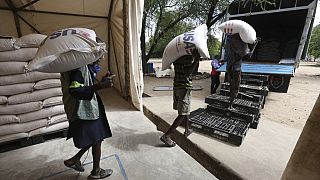Kenya
They are the ravenous pests that are threatening Kenyan farmers.
Swarms of desert locusts have descended on this tea plantation and are destroying every leaf in sight.
East Africa is suffering from its worst locust outbreak in 70 years.
And all farmers can do is sit back helplessly and watch as the insects devour their crops.
But when darkness falls, the farmers fight back.
A company called Bug-Picture has come up with a viable and profitable solution to these menaces.
Sapped of energy after a long day of eating crops, the locusts settle down for the night.
And by torchlight, local people start to harvest them, picking them from the trees without the insects flying away.
Swarms of locusts can travel up to 150 kilometres during the day, so the key to this nighttime harvest is keeping track of their movements until the sunsets.
"We get information from the local scouts in various locations. So once we get information that they (locusts) have been located in an area, so we start pursuing them and normally they set off at around 10 am. in the morning. So we start following them as they move on so by around 5 pm. to 7 pm. that is the time they want to roost," explains Natalina Lopeyok, livelihood officer in Turkana County Kenya.
"So once they roost we mobilise communities around those areas to harvest them overnight because that is when it's most appropriate to harvest locusts, it's at night when they actually are sleepy, they have little energy to move and they are also very lazy. So we harvest them overnight until 6 am. in the morning."
When the dawn comes, the harvesters weigh their haul and are paid for what they have caught.
For farmer-turned-harvester Pharis Githinji, this nocturnal work is almost a form of revenge - but one that helps him feed his family.
"We saw that they are terrorising us by eating the food that we have planted, destroying everything. So I thought let me terrorise them by looking for them and here they are," he says.
"There is someone who is paying us and per kilo they are giving us 50 shillings ($0.50) and you see if I get 10 kilos I will get 500 shillings ($5) and with that I can get flour (meaning a meal), which isn't easy."
Paying for the harvested locusts is not an act of charity - the insects have real monetary value as Bug-Picture turns them into animal feed and fertiliser.
They are ground up and dried.
And there is no shortage of the pests.
Laura Stamford, founder of Bug-Picture, says turning them into animal feed is one solution to the surging swarms that have been plaguing the Horn of Africa recently.
"During the course of February, we harvested 2.5 tonnes of locusts and one of our biggest harvest was 400 kg and that was harvested by about 25 to 30 people," she says.
"So if you look at what this means, if you scale it, it isn't that this is a really insignificant project, this has the ability to be something quite big if we were able to look at larger mobilisation and take advantage of this because these swarms are not disappearing. They are incredibly effective at breeding where every generation is about 10 x (10 times bigger) the one before. So it is something that we all need to contribute to a solution for in order to overcome this as a region."
The ground locusts are taken to JKUAT(Jomo Kenyatta University of Agriculture and Technology) where they are milled and mixed with other experimental diets.
The mixture is fed to chicks under scientific conditions to monitor how the birds respond to the food source.
Dr. Mathew Gicheha, who works in the department of animal science at JKUAT(Jomo Kenyatta University of Agriculture and Technology), says that experiments are still being done on the effects of the locust meals.
But they already know a locust-based feed is higher in protein than soy and fish used in some animal feeds.
"The insects' sources of protein are more advanced or are more, in terms of growth performance, are better than our traditional sources," he says.
"We expect that the locusts meal, which in terms of laboratory analysis is superior than the other protein sources, will give us good performances."
Unusual weather patterns have provided the perfect conditions for locust numbers to boom.
Turning them into animal feed is one solution to combating the outbreak.











01:01
Kenya: Visa-free travel now available for many African and Caribbean countries
00:22
Boniface Kariuki, a Kenyan mask vendor shot at close range laid to rest
11:17
Bridging the legal gap in Africa’s digital boom {Business Africa}
Go to video
First Malaria treatment for babies approved
Go to video
AI videos falsely show Kenyan President resigning following deadly protests
02:16
Kenya's William Ruto faces growing discontent over economy and police brutality